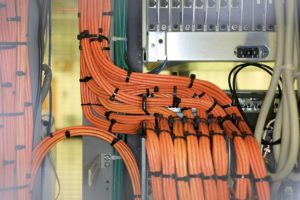
Learn what makes backbone cabling different from horizontal cabling.
Networking requires specific and sometimes complicated cabling. The larger space you are providing a network to, the more complicated this system can become. When installing a cable network, two kinds of cabling are utilized: horizontal and backbone cabling. Both are necessary for establishing a reliable network, but you may not be entirely clear what each does. Read on to learn what defines each type of cabling system, and what each can provide for your network.
What Is Horizontal Cabling?
Horizontal cabling runs from a telecommunications equipment outlet to a telecommunications room or enclosure. This can then be used to connect various workstations and devices to information outlets that run to the telecommunications room. Horizontal cabling is most commonly Category-Rated Twisted Pair, but fiber optic cables are preferred to best support your network.
What is Backbone Cabling?
Sometimes called vertical or riser cabling, backbone cables are used to provide interconnection between various spaces: telecommunications rooms, equipment rooms or buildings, and entrance facilities. These cables are used to develop a “skeleton,” or backbone, for the network. The cables often run from floor to floor to provide ultimate connectivity. Backbone cabling can be done with various cables, including coaxial, but fiber optic cabling is the preferred choice for backbone cabling as it allows for much higher bandwidth.
Essential Components of Large Networks
Horizontal and backbone cabling cover different aspects of telecommunications services, but they are both equally essential. In particular, these cabling systems help support large networks in corporate or academic settings. It is also crucial to remember that the types of cables used in your horizontal and backbone cabling systems are essential to your network’s performance. Backbones should always provide bandwidth that is higher than that of the horizontal cables. Consult with a networking and cabling professional before deciding on what to install for your structured cabling systems.
Get in Touch with FiberPlus
FiberPlus has been providing data communication solutions for over 25 years in the Mid Atlantic Region for a number of different markets. What began as a cable installation company for Local Area Networks has grown into a leading provider of innovative technology solutions improving the way our customers communicate and keeping them secure. Our solutions now include:
- Structured Cabling (Fiberoptic, Copper and Coax for inside and outside plant networks)
- Electronic Security Systems (Access Control & CCTV Solutions)
- Wireless Access Point installations
- Public Safety DAS – Emergency Call Stations
- Audio/Video Services (Intercoms and Display Monitors)
- Support Services
- Specialty Systems
- Design/Build Services
- UL2050 Certifications and installations for Secure Spaces
FiberPlus promises the communities in which we serve that we will continue to expand and evolve as new technology is introduced within the telecommunications industry.
Have any questions? Interested in one of our services? Call FiberPlus today 800-394-3301, email us at info@fiberplusinc.com, or visit our contact page. Our offices are located in the Washington, DC metro area, Richmond, VA, and Columbus, OH. In Pennsylvania, please call Pennsylvania Networks, Inc. at 814-259-3999.
Do you enjoy clicking “Like” and “Follow?” Be sure to click on our official Google+, Pinterest, Facebook, Twitter, and LinkedIn pages today!